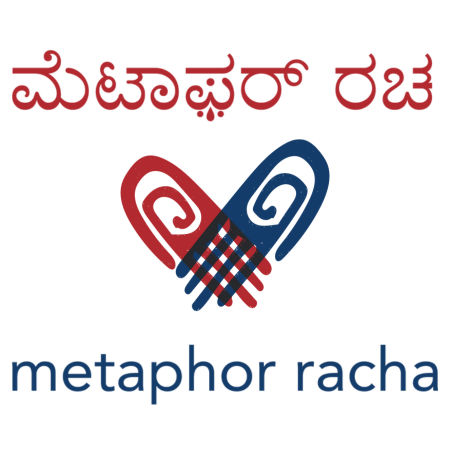For the last couple of years, at Metaphor Racha, we have made it a point to travel outside of our state Karnataka at least once a year to collaborate with a different craft/craftsperson. The idea is to offer a value-based product to our customers by responsibly collaborating with craftsperson through a healthy exchange of knowledge and mutual respect.
Coming together of Metaphor Racha with any traditional rural craft is not only to make an impact on a wider audience but also an understanding of co-creating a product through interdependency, respecting cultural significance, knowing the human value chain and bringing their stories to the forefront.
In early 2019 we had introduced a collection of hand block printed Kalamkari sarees from Pedana, Andhra Pradesh.
This year, we have worked with the craftspeople of Bagru, Rajasthan.

🌸
Hailing from Bengaluru, my Hindi is notorious amongst many of my friends, to a point, I am told that my interpretation of the language is hilarious. Last year I had managed with my multi-linguistic talent, which was with my broken Telugu, English and a bit of sign language thrown in at Pedana (AP), this time around I decided to indulge in the Marwari language. What I did not know of, but realized after reaching Bagru is, they can all talk in Hindi.
🌸
So, I voluntarily restricted my Marwari learning skills to only one word "Khamma Ghani".
🌸
"Khamma Ghani" is a general greeting in the Marwari language wherein, "Khamma" literally means "kshama", or forgiveness. And "Ghani" means "a lot". I believe it was to seek in advance for any ill-feelings raised by the course of one's words/actions. But today it is used very commonly as a "hello" or a "welcome".
🌸

🌸
Bagru, a small town, 35 kilometers from the city of Jaipur in Rajasthan is popular for its hand block printing using traditional techniques with natural dyes. The Chippa community settled here for more than 400 years still practice the craft of block printing. Due to the awareness and it's the goodness of this craft, the prints from Bagru seems to have gained popularity for some time now both in the local market and outside India.
🌸
Last December I happened to stay at Bagru for a week to understand what is being practiced, by whom, how and why and in the process we came up with a small collection of saris and stoles.
🌸
I won't get into writing too much about the prints, designs, and processes at Bagru as most of them are Googleable. Many academicians, influencers, and consumers have already done a commendable job in spending enough time gathering information on the internet about this craft and writing about it to popularize and they have been successful at it also. Sometimes the ground realities are somewhat different from what Google suggests of what the craft should ideally be. Also, Google seldom shows results for crafts-persons emotion. Nevertheless, Bagru and their prints are popular.
Often, popularity comes with challenges.
🌸
Though the popularity of this craft has brought a huge volume of work and tourists, the town itself is not built for the 'scale'. Dried up Sanjaria river and its sandy bank, lack of civic amenities, the dearth of skilled labor and their living wages, and even unavailability of common space to dry the printed/dyed fabrics are today's realities. The Sanjaria river surrounding Bagoria (ancient name for Bagru) making it an island is unimaginable today.
🌸
Every print which comes out of Bagru is popularly known as Bagru print and I think that's somewhat discriminatory. Nowadays, block printing in chemical dyes, screen printing in pigment, resist print but dipped in chemical dyes, chemical print but dipped in natural dyes, wax printed and naphthol dyed are some of the few examples which are popularly sold as Bagru prints. The list of this "GI tagged" craft can go on and on but the end buyer will not be able to differentiate between the authentic and it's exceptionally made counterfeit.
🌸
Hence, I request consumers to understand, differentiate and address the printed fabric with specific names associated with the technique. Ideally, it should sound like 'Dabu print', 'Syahi-Begar print', 'Jahota print' (Jahota is also the name of a place close to Jaipur) and 'Phadat print' and not necessarily 'Bagru print'. It's only fair for those craftspeople who are working hard to retain the authenticity of the craft.
🌸
Many of the skillful printers are focused on printing and not so much on the base fabric, and rightly so. Mostly, the saris are printed on power-loom fabric and rarely on handloom let alone on handspun and hand-woven muslin cotton fabric.
🌸
At Metaphor Racha, we have not only been a part of knowing where the cotton is sourced from, how its ginned and slivered, who does the spinning and weaving, but also in being aware of the entire process and people behind scouring, mordanting, printing, dyeing, washing, and finishing the saris. We are aware of the number of working hands, the effort, and their remuneration. Adding to it, we have consciously tried working with a small printing unit, as a small brand ourselves we can very well comprehend the difficulties. Most importantly at Metaphor Racha, we understand, what is enough. Enough as in both in quantity of production and thereby the usage of local natural resources.
🌸
This "Journey of a sari" has been long, challenging, enriching and humbling. Hopefully, I will get a chance to share the detailed process behind each technique and every single sari with you in person soon.
We present our work from Bagru, wishing you Khamma Ghani.

